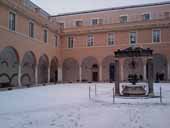On a test bench for studying lubrication in a spherical bearing: simulations and experimental validation
Tuesday, 08 May 2012 14:49
Tribotest
also Published online in Wiley InterScience, J. Wiley and Sons
On a test bench for studying lubrication in a spherical bearing: simulations and experimental validation
Belfiore,N.P., Faralli, M., Presta, M., Moretti, M., Ianniello, F., Scaccia, M., Consorti, L.
Vol. 12, Issue 4, 2006, pp. 287 – 308
ISSN: 1354-4063, DOI: 10.1002/tt.26
Abstract
In this paper a test bench dedicated to the analysis of a lubricated spherical pair is presented. The experimental set-up has been used to validate a numerical code that has been developed by the authors in order to simulate a complex lubricated spherical pair that affects the reliability of a novel continuous variable transmission (CVT). The test bench is modular and can be adapted to other lubricated pairs, either cylindrical or spherical. The stand is equipped with an I/O control card and allows the on-line acquisition of some important parameters. As for the numerical code, the finite-difference method has been used to solve the indirect problem in the lubricated spherical pad, under the condition of hydrodynamic regime, with externally pressurized inlets. Two simulators are needed since the physical properties of the test bench and the real system are different. The one that simulates the behavior of the spherical pair in the test stand has been used to ascertain the numeric approach prediction capability. Indeed, the experimental tests gave results which are in very good correspondence with the numerical predictions. Hence, the second simulator, which has been tailored on the particular spherical pair the CVT is equipped with, gained reliability in predicting the behavior of the real system under different load and speed conditions. These predictions have been useful in achieving new insights into the novel CVT, which, under this new light, has been criticized by making the point that its range of application in automotive is, at the actual state of the art, rather limited, in spite of a high intrinsic complexity.






